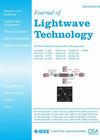Mechanical Resonance Multiplexed Magnetic Communication via Magnetoelastic Heterostructured WGM Resonator
IF 4.8
1区 工程技术
Q2 ENGINEERING, ELECTRICAL & ELECTRONIC
引用次数: 0
Abstract
Magnetic communication offers stable signal propagation in non-line-of-sight, underwater, and cross-medium environments. Optical whispering gallery mode (WGM) resonators, known for their ultrahigh quality factors and sensitivity to weak perturbations, inherently support multiple mechanical modes and can be used for multi-channel parallel magnetic communication. However, the mechanical resonance modes are sparsely distributed and exhibit inconsistent response strengths, which limits the number and reliability of available communication channels. Therefore, we introduce a magneto- elastic heterostructured resonator integrating Terfenol-D to enhance magnetoelastic coupling, which significantly augments the density of frequency domain communication channels with nearly uniform response. Experimental results demonstrate the use of 10 parallel mechanical subcarriers to achieve a total data rate of 12.5 kbps—an order-of-magnitude improvement over single channel designs—with potential for further scalability. By employing multimodal resonance multiplexing with a microcavity-based sensor, our work establishes a new paradigm for high-capacity, short-range magnetic communication in complex environments.基于磁弹性异质结构WGM谐振器的机械共振多路磁通信
磁通信在非视距、水下和跨介质环境中提供稳定的信号传播。光学低语通道模式(WGM)谐振器以其超高质量因子和对弱扰动的敏感性而闻名,固有地支持多种机械模式,可用于多通道并行磁通信。然而,机械共振模式分布稀疏且响应强度不一致,这限制了可用通信通道的数量和可靠性。因此,我们引入了一种集成Terfenol-D的磁弹性异质结构谐振器,以增强磁弹性耦合,从而显著增加频域通信信道的密度,并且具有几乎均匀的响应。实验结果表明,使用10个并行机械子载波可以实现12.5 kbps的总数据速率,比单通道设计提高了一个数量级,具有进一步可扩展性的潜力。通过使用基于微腔传感器的多模态共振复用,我们的工作为复杂环境下的高容量、短距离磁通信建立了一个新的范例。
本文章由计算机程序翻译,如有差异,请以英文原文为准。
求助全文
约1分钟内获得全文
求助全文
来源期刊

Journal of Lightwave Technology
工程技术-工程:电子与电气
CiteScore
9.40
自引率
14.90%
发文量
936
审稿时长
3.9 months
期刊介绍:
The Journal of Lightwave Technology is comprised of original contributions, both regular papers and letters, covering work in all aspects of optical guided-wave science, technology, and engineering. Manuscripts are solicited which report original theoretical and/or experimental results which advance the technological base of guided-wave technology. Tutorial and review papers are by invitation only. Topics of interest include the following: fiber and cable technologies, active and passive guided-wave componentry (light sources, detectors, repeaters, switches, fiber sensors, etc.); integrated optics and optoelectronics; and systems, subsystems, new applications and unique field trials. System oriented manuscripts should be concerned with systems which perform a function not previously available, out-perform previously established systems, or represent enhancements in the state of the art in general.
 求助内容:
求助内容: 应助结果提醒方式:
应助结果提醒方式:


